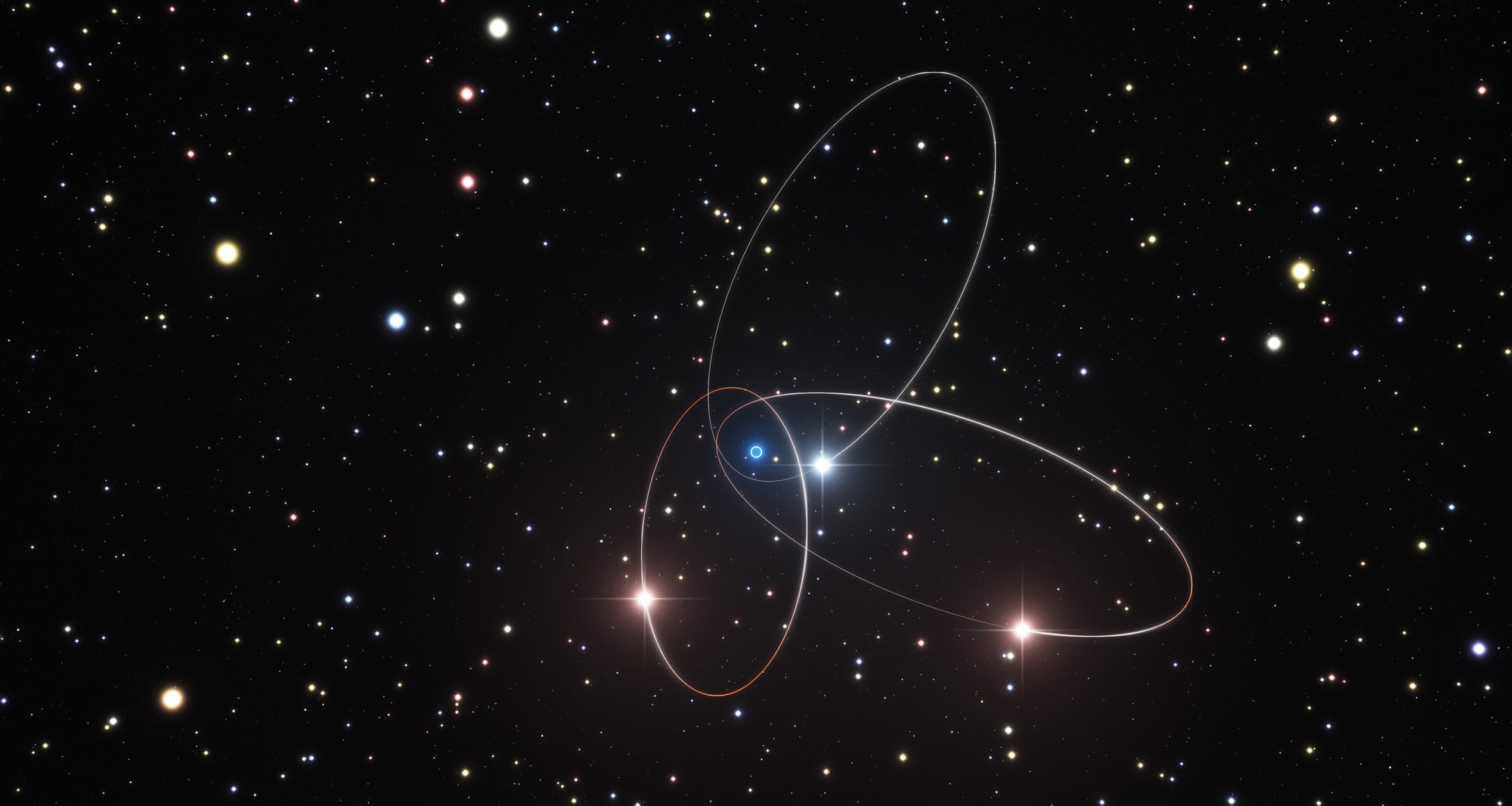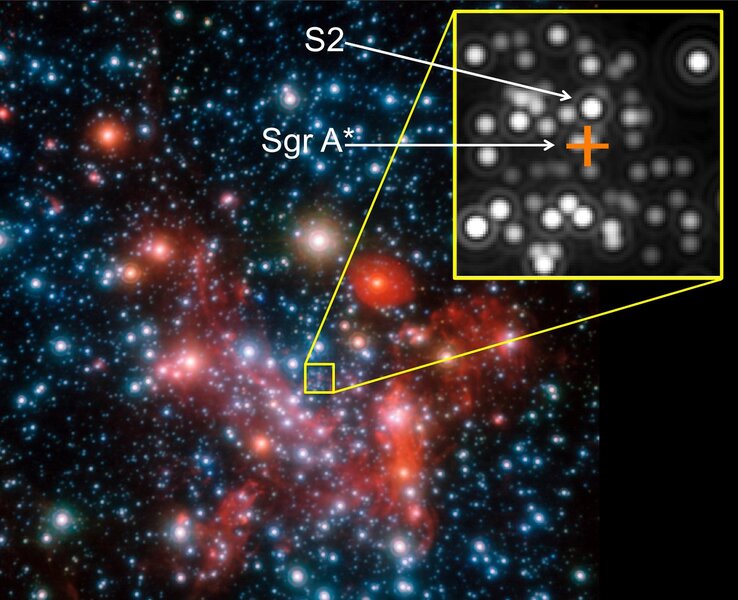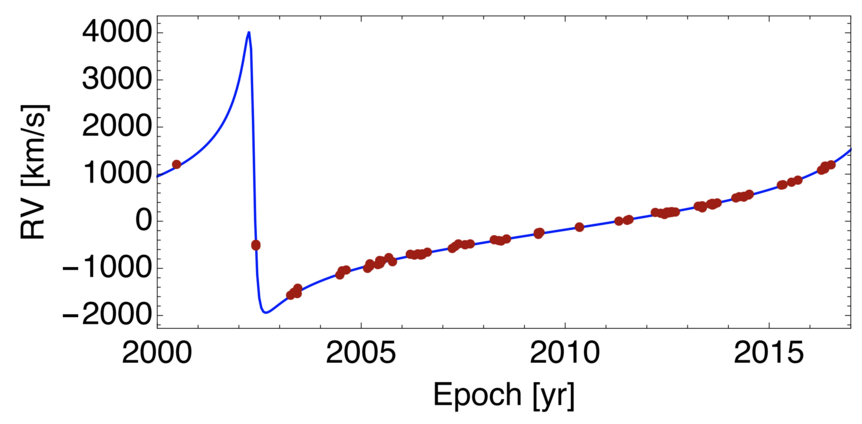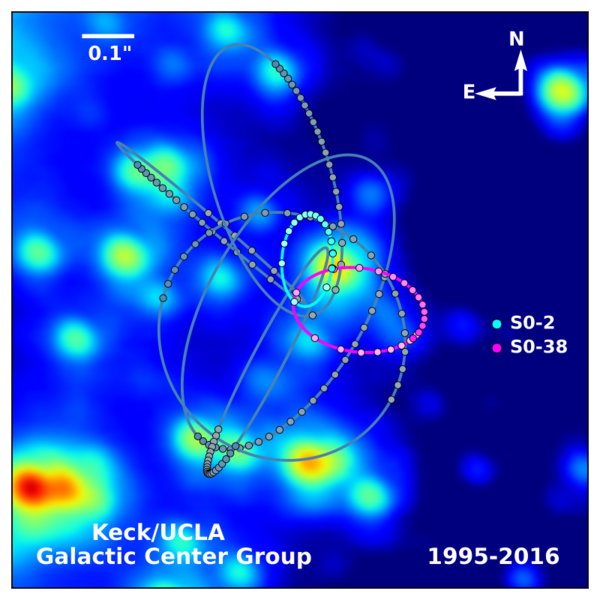Create a free profile to get unlimited access to exclusive videos, sweepstakes, and more!
A star is about to plunge head first toward a monster black hole. Astronomers are ready to watch.

Sometime over the next few months, a massive star is going to take a deep plunge near a gigantic black hole in our galaxy. As it screams past the monster at terrific speed, astronomers all over the Earth will be watching it carefully to see how it behaves.
A new set of observations of the star made over the past few years as it’s been picking up speed has given astronomers the go-ahead to make precise measurements of just how the black hole's excruciatingly fierce gravity will affect the star’s orbit. This is good news, because it means there won’t be any added complications to what will already be difficult observations.
The star is called S2 (or sometimes S0-2). It's a bit of a bruiser, a B-type star about 15 times more massive than the Sun. That means it's pretty luminous, which is convenient: That makes it easier to spot from its distance of 26,000 light-years away.
There are likely upwards of a billion stars like that in our galaxy, but S2 is special: It orbits very, very close to the supermassive black hole in the center of the Milky Way.
All big galaxies have a huge black hole like this in their hearts. Ours, called Sagittarius A* (pronounced, literally, "Sagittarius A star," or Sgr A* for short) is roughly 4 million times the mass of the Sun, which is staggering on a human scale, but actually a bit of a lightweight when it comes to black holes like these. The exact mass of Sgr A* would be very nice to know, because we think the formation of a central supermassive black hole and the galaxy around it are tied together. Several galactic features tend to scale with the mass of the black hole, so the more we know about ours the better we'll understand our galaxy.
And that’s where S2 comes in. It orbits Sgr A* on an ellipse that takes about 15 years to complete. The diameter of its orbit is about 300 billion kilometers, which may sound like a lot, but we're talking about a supermassive black hole here! That’s close!
And it gets closer. Because the orbit is an ellipse, the star drops down to a mere 18 billion kilometers from the black hole, a positively terrifying close approach. That’s only four times farther from the black hole than Neptune is from the Sun.
When it does this, the gravity of the black hole is so fierce it'll accelerate the star to about 6,000 kilometers per second — fast enough to cross the continental U.S. in less than a second! That's an entire star ripping through space at 1/50th the speed of light, in case you were fretting over some mundane issue in your life right now. Perspective.
By making exacting measurements of the star over time, the mass of Sgr A* can be found. Using observations from the last pass of S2 in 2002, and also using observations of the motions of other stars orbiting the black hole, astronomers have found the mass of the black hole to be 4.15 million solar masses.
Cooooool. But there's more.
That close to a black hole, relativistic effects predicted by Einstein’s equations start to become important. For example, the light from the star will have to fight the gravity of the black hole to get to us, losing energy on its way out. This is called a gravitational redshift. When an object approaches or moves away from an observer, the light shifts in wavelength a bit, which is just plain old redshift. The amount of the shift depends on the velocity.
In the case of S2, at closest approach gravitational redshift acts like another 200 kilometers per second added to the star's motion! That's enough to measure pretty easily, so astronomers should definitely see that.
Another effect is that the orbit of the star shifts, rotating a little bit. What this means is that if you draw a line through the long axis of the star's orbit, every time it whips around the black hole that line rotates a bit. This is called "relativistic precession" of the orbit. This effect is small and more difficult to detect, but it’s precisely what astronomers hope to see when S2 makes its close encounter sometime over April to June of this year.
And that (finally) brings me back to the new observations. Stars like S2 are commonly binary, that is, have a companion star orbiting them. If S2 has one, that can mess up the observations. For example, at closest approach to the black hole, the gravity of the black hole can affect the orbit of the companion, changing its shape significantly. This in turn will affect the motion of S2, and that motion is the key factor to perform all these calculations!
So a team of astronomers used old data as well as making new observations of S2 to look for a companion. They took spectra, breaking up the light from the star into thousands of colors, to see if they could detect a redshift in the light due to the motion of a companion around the star. Long story short, they didn't see one. Also, a companion star gives off its own signature of light, different than the primary star, but they didn't see any hint of that either.
However, that doesn't mean there isn't one! Maybe it's too low mass to have much of an effect. So the scientists did the math, and determined that the star can't be any more massive than roughly 1.6 times the Sun, or else they would have seen it (also, a more massive star would have to be farther out from the primary star to hide its effects, and if it's too far out the black hole would have torn the binary apart ages ago).
Even if there is a companion, what they found is that it won’t affect the relativistic measurements very much, far less than the overall relativistic effects in the first place. However, astronomers need to be aware of any potential perturbations by a possible companion, so this study will be very helpful in the coming months as scientists pore over the data they'll be taking.
That's good to know. The only bad news here is that the astronomers who took the spectroscopic observations were hoping to get some insight on how S2 formed. Was it born from material swirling around the back hole perhaps tens of millions of years ago? Did it form in a star cluster, several of which are seen near the black hole? Another possibility is that it used to be a binary on a longer orbit around the galactic center; on a close approach to the black hole the secondary companion would have been torn from the star and flung away at high speed, leaving S2 in its weird looping 15-year orbit around Sgr A*.
Unfortunately, the new observations don't help narrow down S2’s origins. Perhaps further observations may help us understand where it came from; we still don't truly understand the environments around these monster black holes, and knowing how stars get there would be helpful.
But that doesn't cast any shade on the big story, which is that we're ready for S2 to take its Einsteinian plunge down the steep well of Sgr A*'s intense gravity. Will we be able to see its orbit change, and the implacable force of gravity affecting its light, and get better constraints on just how whopping a black hole Sgr A* is?
Stay tuned. As soon as I know, so will you!

















